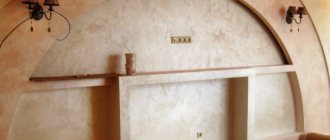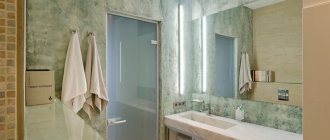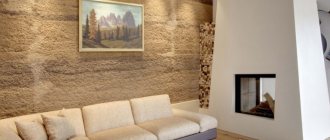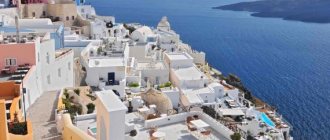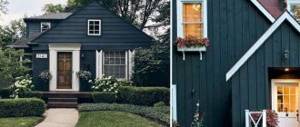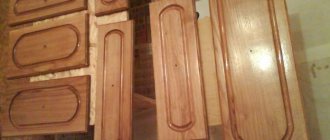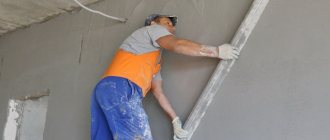Facade plaster - what is it, application features
Modern plasters are multicomponent mixtures, the components of which are cement, sand, synthetic acrylic components and silicone. Facade plaster has the following characteristics:
- High breathability. Thanks to this, a greenhouse effect will not be created indoors. Accordingly, mold, stains and discoloration will not form on the internal and external surfaces of the walls;
- Resist temperature changes;
- Show resilience when exposed to negative external factors;
- Be comfortable when applying;
- Do not react by displaying defects under mechanical influence.
When choosing plaster, take into account that premium-class material is visually attractive and has unchanged characteristics for up to 20 years. Whereas materials in the economy class segment will require repeat repairs once every 10 years.
Facade plaster has a high breathability rate.
Advantages of the material:
- High level of environmental friendliness;
- Low flammability;
- Light weight, allowing you not to overload the wall when finishing;
- Moisture resistance;
- Passage of steam and air;
- Aesthetic indicators are provided by color solutions and obtaining a variety of textures.
But, despite the numerous positive aspects, the material also has negative aspects. Pay attention to the following:
- Inferior in strength to some other types of finishes;
- They get dirty easily, and it is not always possible to remove such dirt.
Aesthetic indicators are provided by color solutions and obtaining a variety of textures.
Types of facade plaster for exterior work
The range of finishing materials is wide, which allows you to implement any ideas for exterior design.
Facade plaster for external use may differ in the composition of the components included in the mixture. Therefore, it is necessary to very carefully select the types of mixtures for the implementation of this or that work.
The range of finishing materials is wide, which allows you to implement any ideas for exterior design.
Cement
One of the most frequently used. It consists of: cement, a small amount of lime and sand - fractions of different sizes. Depending on how large the sand particles are used in the mixture, how uniform or grainy the texture of the coating will be.
Advantages:
- Improved bond with the surface. Therefore, chips, cracks and other defects that can reduce the aesthetic component do not form on the surface;
- This type of plaster is often used in humid climates, as it does not react to high humidity;
- Low price.
Flaws:
- Takes a long time to dry;
- Difficult to apply;
- To level the wall, it is necessary to apply a pre-reinforced mesh.
This type of plaster is often used in humid climates, as it does not react to high humidity.
Silicate
Decorative facade plasters based on potassium and sodium are called silicate.
Advantages:
- High vapor permeability;
- Surfaces are fireproof;
- They do not attract dust, which allows them to remain visually attractive and clean for a long time;
- The external changing environment, as well as negative influences, do not have any significant impact.
Flaws:
Difficult to apply. Therefore, you should not do the finishing with silicate plaster yourself. It is better to involve professionals for this manipulation who will do the work taking into account the peculiarities of the technology.
They do not attract dust, which allows them to remain visually attractive and clean for a long time.
Acrylic
Plaster for external use, made on an acrylic basis, allows you to create a variety of textures in your design.
The main distinguishing feature of this type of plaster is its bactericidal components, which prevent the appearance of fungus and mold.
Advantages:
- Adding color makes it possible to create any color scheme for the facade;
- Exposure to ultraviolet radiation does not change the shade of the walls over a long period of time;
- Due to the fact that acrylic plasters are a very elastic material, they are good for filling small cracks.
Flaws:
- High cost of finishing work and price of material;
- Due to the fact that the mixture dries quite quickly, it must be applied quickly;
- The electrostatic nature of the acrylic surface intensively attracts dust, which, in combination with the structural plane, can contribute to faster contamination compared to other materials. True, due to its immunity to moisture, you can simply clean the wall by spraying it with a hose.
Plaster for external use, made on an acrylic basis, allows you to create a variety of textures in your design.
Silicone
Silicone resins, which are included in the exterior plaster of the house, can increase the elasticity of the material. As a result, an extremely smooth surface is obtained.
Today, manufacturers offer about 200 color solutions for silicone plaster.
Advantages:
- The non-wettable surface is achieved due to the high hydrophobic property;
- High adhesion to almost any surface;
- Capable of good air permeability;
- Immune to sound and vibration transmission.
Flaws:
- Its price is quite high;
- In addition, special treatment with silicone impregnations (primers) will be required, which further increases the final price of such work.
Silicone resins, which are included in the exterior plaster of the house, can increase the elasticity of the material.
Mineral
Facade plaster, made on the basis of cement, clay of different colors, stone chips and slaked lime, is a mineral material.
It is able to withstand fairly low temperatures, which makes it indispensable for use in northern regions. It retains its appearance for a long time even at winter temperatures down to -50°C.
Advantages:
- Non-flammability;
- Above average sound insulation performance;
- Good properties to retain heat indoors, which is coated on the outside with such a finishing composition.
Flaws:
- You should not use the mixture if you need to plaster a surface that is subject to excessive vibration. Since mineral mixtures are unstable to fluctuations;
- The peculiarity of achieving the coloristic effect of such a surface. The fact is that it is impossible to add color to such a mixture. Therefore, if there is a need to give a certain shade to the facade, you will have to paint it.
Walls covered with mineral plaster can be painted only after the composition has completely dried and hardened for several days.
Good properties to retain heat indoors, which is coated on the outside with such a finishing composition.
Terrasite
Plastering the facade with terrazite mixture will provide an original appearance due to the inclusion of such components as:
- Marble chips.
- Mica elements.
Advantages:
- It is they, along with cement, lime and sand, that create not only a durable surface;
- Original texture and texture, which allows you to create highly aesthetic surfaces.
Flaws:
- It must be taken into account that plastering with such a mixture is quite difficult;
- It will dry over a long period of time.
Plastering the facade with terrazite mixture will provide an original appearance.
Cork
Outdoor plaster made from cork material is suitable for those who are trying to decorate not only the interior, but also the exterior in an environmentally friendly style. The specificity is that among the binding components there are oak bark in a crushed state. It is thanks to this that the use of this material makes it possible to obtain a textured wall.
Advantages:
- Antistatic;
- Tactile softness;
- High degree of elasticity;
- Eco-friendly coating.
Flaws:
- High crumbliness;
- Insufficient mechanical wear resistance.
Outdoor plaster made from cork material is suitable for those who are trying to decorate not only the interior, but also the exterior in an environmentally friendly style.
Kinds
Plaster can be cement, silicate, acrylic, silicone, mineral, terrazite, cork and other types. They differ to one degree or another in external characteristics, decorativeness, price and performance indicators. Manufacturers rarely manage to combine all the advantages in one option, especially while keeping its price at the level of the market average. The scope of application requires materials to be resistant to thermal and chemical influences, as well as the ability to transmit steam and moisture resistance. Ordinary plaster should first of all protect the building from moisture penetration. Decorative varieties are often used on top or instead of the usual mixture. Special options perform a shielding function. Provide reliable protection against physical and chemical factors. Special ones are often added to decorative mixtures.
Cement
Several varieties are called this way. The market is dominated by cement-lime and cement-sand options. It is the fillers that determine the basic properties of the raw material and, accordingly, the scope of application. Options with sand are cheaper, and more expensive putty with lime is used in rooms with high humidity. The second option will cost more, even if you prepare the putty yourself. Each of the materials is saturated with sand and lime, so that the mixtures, in fact, differ in the proportion of the main components. According to their purpose, they are divided into decorative, leveling (regular) and special. The latter type is associated with the creation of warm plasters, as well as coatings with enhanced resistance to external factors. Cement plaster has decent indicators of vapor permeability, heat resistance and chemical resistance.
Silicate
The binding function in the mixture is performed by liquid potassium glass. The base consists of minerals. As a result of mixing the components, raw materials with high moisture permeability are obtained. At the same time, the combination cannot provide a normal level of elasticity. The shrinkage of the building will lead to the formation of cracks. A slight earthquake will cause the facing layer to fall off. Silicate plaster is useful for finishing facades near busy roads and highways, but only in flat areas. Special care for the coating is not required, and this despite the fact that the solution fits perfectly on textures of any complexity - such as cellular walls and decorative options. Shell rock is best combined with the material. Finished raw materials are produced in a wide range of shades. Silicate putty is easy to use, but applying it over another layer of plaster will cause cracks.
Acrylic
Apply only to a smooth surface or leveling layer. Acrylic plaster is laid in a thin layer to ensure the main advantage of the material - high elasticity. Moreover, even a small layer of acrylic solution will be resistant to mechanical wear of varying degrees. The integrity of the cladding will remain even after slight shrinkage. At the same time, acrylic putty belongs to the above-average price category, and is also suitable for a limited area of application. For example, due to low vapor permeability, it is better not to use it in hot regions. And the optimal place for use is considered to be vapor-permeable systems made of polyurethane foam and expanded polystyrene. Dust and dirt strongly stick to the coating, so acrylic raw materials will not be the best solution for houses directly near highways and dirt roads, especially if there are no opportunities for washing under high pressure.
Read also: Landscape design ideas for the courtyard of a private house in the photo
Silicone
The option is not cheap, and it is used for finishing “like” stone or some kind of rock. The base is designed to add small particles: from quartz sand, for example, the coating takes on the appearance of stone. The raw materials are used for facades and premises. Plaster looks organically in any interior: from the simplest to the most expensive. At the same time, the outside of the building will be thoroughly cleaned by regular rain, and the inside will be washed with clean water without detergents. The surface under the silicone putty breathes normally and does not suffer from harmful microorganisms. Silicone plaster does not absorb salt, so unpleasant salt solutions do not form on it. Silicone surfaces also have the ability to self-clean. The range of colors and shades includes ready-made solutions, but consumers often resort to tinting the usual white mixture.
For the leveling lower layers, it makes sense to use other materials - this will significantly reduce the final costs.
Mineral
This variety is classified as a dry type of mixture for dilution with water. Mineral plaster is made from cement. Plasticizers and modifiers are added to the raw materials. The material is relatively inexpensive, and this, along with its strength, makes the option profitable in its own right. The putty adheres tenaciously to the base, practically does not absorb moisture, has high vapor permeability, and tolerates frost well. Among the weaknesses of mineral plaster is the small choice of colors. To give the walls a special shade, you will need tinting. Elasticity indicators are also low. If the building shrinks, cracks will appear in the finish. Recently, they began to produce mineral putty based on gypsum. In terms of basic qualities, such solutions are inferior to other types of plaster. Mineral mixtures are also made from:
- liquid glass;
- lime
Terrasite
The material performs decorative and protective functions. The range of terrasite plaster includes many different compositions, among which a mixture of fine limestone flour, Portland cement and fluff lime is popular. Instead of limestone chips, coarse purified sand is sometimes used as a filler. The mixtures usually contain additives such as mica chips. Buyers can choose the desired option for transportation directly to the construction site: they sell terrasite plaster only in the form of a dry mixture, and add water just before application. Most varieties are used externally, because the resulting texture turns out to be too textured for interior finishing standards. You can find an option for rooms if you select putty with small fractions and a suitable pattern after hardening.
Cork
A relatively new type of decorative finishing plaster with a special composition. The basis of the raw material is cork oak bark, and additives and binders are selected according to its characteristics. The properties of cork will also be obtained by the finished coating: antistatic, hypoallergenic, elastic, soft. The variety was developed to replace traditional options with increased decorativeness. Cork plaster is used instead of wall and ceiling cladding, thin insulation, paints, liquid wallpaper, interior and facade decoration. Among other things, it will act as water and sound insulation and increase the strength of wall materials. The described benefits will be available for at least 15 years - that is how long the integrity of the structure is maintained. Gaps are also filled with natural cork putty. It is used in repair work and finishing of the following types of buildings:
- Made from expanded clay blocks;
- Foam concrete;
- Aerated concrete;
- Panel.
Thermal insulating
The warm type of plaster appeared relatively recently. Thermal insulating putty was obtained by modernizing the composition. Quartz sand was replaced with elements to contain heat: expanded polystyrene, pumice, expanded vermiculite, expanded clay and other materials. Packaged air almost always plays the role of an insulating barrier for a room. In the warm type of plaster, the appearance of cold channels is prevented by polystyrene foam and expanded vermiculite, which are characterized by attracting and retaining air bubbles. High adhesiveness is ensured by universal properties in terms of compatibility with surfaces. A layer of plaster 5 cm thick corresponds to a sheet of polystyrene foam with an index of 4 cm and one and a half rows of bricks. A perfectly even base coat is not required for the work, and more than 100 m² can be applied at a time.
Other strengths:
- ease of preparation;
- fire safety;
- environmental friendliness.
Soundproof
Such materials are used in libraries, consulting, office centers, restaurants, and industrial premises near residential buildings. Soundproofing mixtures are saturated with light fillers, divided into granules. Additives with a hollow structure are used for this. For soundproofing properties, the mixtures are also saturated with aluminum powder. The latter, as a result of drying the plaster, emits gas to form a porous structure. In the loose structure of the plaster, the sound bounces off small particles and eventually weakens to a minimum level. At the same time, the preservation of properties depends on the choice of decorative layer, if one is planned. Thick enamel paints will definitely ruin the effect. It is generally better not to use paints and varnishes, as they penetrate into the porous layer and clog some of the pores.
Which one to choose, depending on the design and material of the walls
Cement plasters are suitable for cladding walls made of aerated concrete, concrete and brick. Silicate ones look and serve best on concrete surfaces and those covered with plasterboard sheets. Silicone materials are not used for external insulation. To cover the external insulated surface, experts recommend using mesh for reinforcement.
Cork material is suitable for finishing aerated concrete, wooden surfaces, expanded clay blocks, plastered surfaces, as well as those on which synthetic plastic materials have been used.
Venetian plasters have now gained the greatest popularity among decorative plasters. Thanks to a specific application technique and suitable materials, it is possible to create an effect similar to valuable stones or leather. Color effects are achieved through the use of special pigments.
It must be taken into account that color is achieved in two ways - by acquiring the desired shade or by adding color to the main mixture.
Venetian plasters have now gained the greatest popularity among decorative plasters.
Varieties and their features
Depending on the area of application, mineral plaster is divided into different types. For example, it can be allocated for indoor work or for facades. The differences will be significant, and above all in resistance to weather conditions. The decorative component is also important in this regard. But there is some contradiction: the mineral finishing material has excellent resistance to external conditions, but it looks better in interior decoration than on the exterior walls of the house. Therefore, where exactly to use it is up to the owner.
Almost all decorative plasters with a mineral base belong to the thin-layer group, because the thickness, and as a consequence the consumption of the plaster, will depend on the size of the granules. Typically, the size of the fine fraction in plaster is from 2 to 5 millimeters, which affects whether the treated surface will look rough. This is a feature of various mineral plasters for facades.
Pebble mixture
It is also called “lamb” because in some ways its texture is comparable to the wool of a young sheep. The structure of this species consists of a large volume of small granules. This plaster requires a special application technology - it is laid on the surface using a polisher.
Plaster bark beetle
This differs from the pebble type of decorative plaster for facades mainly in only two parameters - its appearance, due to a smaller amount of granular filler, as well as a different application technique. Surfaces are treated with bark beetle not in a circular motion, but only in one direction - either horizontally or vertically;
DIY fur coat
Shuba is a common, common type of mineral solution. Its mineral base is somewhat different from two bark beetles and a pebble mixture, which is why the application technique for the fur coat is also different. This technique and composition make it possible to create a pimply structure: the plaster is first carefully smoothed, after which a half-polish is applied to each area, held and sharply torn off - this technique is responsible for the small bumps on surfaces trimmed with fur coats.
Creative compositions
They are highlighted as a separate type and are intended for independent creation of any structures of interest. But such materials are only for people with experience. With their help, a professional is able to create full-fledged ornaments and all kinds of designs on the surface of the wall. In general, this type of plaster is a regular mixture without granular filler - the plastering master must add all the components he needs himself. What exactly needs to be added depends solely on the desired end result. You can do without filler altogether, in which case you will need a special application technique and a special tool.
General rules for applying facade plasters
There are guidelines that should be maintained. For each plaster composition, it is necessary to take into account the method that will be technologically correct. Only in this case can you obtain a good, high-quality surface that meets all basic requirements. It is very important in any case to use a primer before applying plaster. This improves adhesion and, accordingly, the service life of the coating.
The primer improves adhesion and, accordingly, the service life of the coating.
According to insulation
If the walls of the building were covered with insulation on the street side, then before applying plaster, you must first fix the reinforcing mesh over the entire plane.
After fixation, alignment is performed. In this case, a base is created for subsequent plastering.
If the walls of the building were covered with insulation on the street side, then before applying plaster, you must first fix the reinforcing mesh over the entire plane.
On brickwork
For a brick wall, it is very important to carefully prime and set the beacons. Then, according to the technology, it is necessary to moisten the wall and apply the first layer by spraying, after which the plane is leveled.
For a brick wall, it is very important to carefully prime and set the beacons.
"Wet"
The “wet” method is actually a “sandwich” of several layers. Thanks to insulation along the outer plane, it is possible to reduce the greenhouse effect indoors.
Wet plaster is applied following the following basic steps:
- Preparatory stage - during this stage the surface for plastering is processed;
- Knead the mixture and leave for several minutes to infuse;
- Apply using a spatula or trowel.
But, depending on the selected technological process, a certain effect can be achieved:
- Crushed silk - in this case, use a special wet sponge, which is chaotically stuffed onto the surface and then leveled with light movements using a spatula;
- Wet silk - apply several layers. Moreover, until the first layer has dried, apply the second one. Use a trowel to level the surface, removing layers so that curls and wavy textures are formed;
- Classic silk - apply a base layer. Let it dry completely. Then the second layer is applied in small areas of 4 m2. Smooth the surface with sweeping movements.
Thanks to insulation along the outer plane, it is possible to reduce the greenhouse effect indoors.
Facade mineral plaster
Another multicomponent composition for finishing the facade of a building is made on the basis of silicates with the addition of mineral fillers and other auxiliary pigments. Such mineral plaster does not attract dust and has a good degree of breathability, but is rare due to reduced demand due to high prices. Due to low elasticity, it is advisable to use facade decor for walls with a porous texture. But the main advantage of mineral plasters is the formation of a durable and reliable cladding of the house.
Regarding decoration, it is advisable to purchase mineral and marble plasters containing large fractions of various additives, the diameter of which starts from 2 mm and above. Large granules most clearly and distinctly form an attractive surroundings. However, many adhere to traditions and decorate the facades - they achieve well-known stylistic techniques: “bark beetle”, “lamb”, “travertine”. Which you can see “live” in our showroom in Moscow, St. Petersburg and the online store catalog, and buy at a discount at a low price.
Main manufacturers of plasters for external use
Before choosing a specific type of plaster, you need to consider the following factors:
- Climatic conditions of the region;
- Financial opportunities. in this case, take into account not only the current costs of carrying out this type of work, but also the delayed effect. The fact is that if you initially invest in more expensive plaster, you will have to redo the work much less often. And this will help save money in the future.
If you initially invest in more expensive plaster, you will have to redo the work much less often.
It is also necessary to choose not only the composition, but also the brand. This will provide a guarantee of quality. It is worth paying attention to such manufacturers as:
- Ceresit.
- Knauf.
- Prospectors.
It is necessary to choose not only the composition, but also the brand.
Taking into account all of the above features and characteristics, as well as subtle points in technology, it will be possible to create the optimal surface for a private home. Since today's additional pigments avoid white or cement-gray surfaces, you can diversify the design and improve the attractiveness of the exterior.
